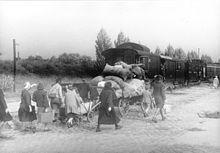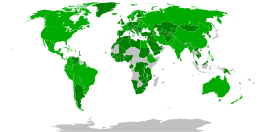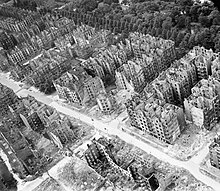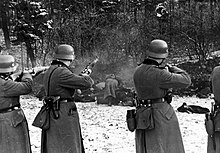
Ethnic cleansing is the systematic forced removal of ethnic, racial, or religious groups from a given area, with the intent of making the society ethnically homogeneous. Along with direct removal such as deportation or population transfer, it also includes indirect methods aimed at forced migration by coercing the victim group to flee and preventing its return, such as murder, rape, and property destruction. Both the definition and charge of ethnic cleansing is often disputed, with some researchers including and others excluding coercive assimilation or mass killings as a means of depopulating an area of a particular group.
The Convention on the Prevention and Punishment of the Crime of Genocide (CPPCG), or the Genocide Convention, is an international treaty that criminalizes genocide and obligates state parties to pursue the enforcement of its prohibition. It was the first legal instrument to codify genocide as a crime, and the first human rights treaty unanimously adopted by the United Nations General Assembly, on 9 December 1948, during the third session of the United Nations General Assembly. The Convention entered into force on 12 January 1951 and has 153 state parties as of June 2024.

Raphael Lemkin was a Polish lawyer of Jewish descent who is known for coining the term genocide and campaigning to establish the Genocide Convention. During the Second World War, he campaigned vigorously to raise international awareness of atrocities in Axis-occupied Europe. It was during this time that Lemkin coined the term "genocide" to describe Nazi Germany's extermination policies.

The term genocidal massacre was introduced by Leo Kuper (1908–1994) to describe incidents which have a genocidal component but are committed on a smaller scale when they are compared to genocides such as the Rwandan genocide. Others such as Robert Melson, who also makes a similar differentiation, class genocidal massacres as "partial genocide".

Ethnocide is the extermination or destruction of ethnic identities. Bartolomé Clavero differentiates ethnocide from genocide by stating that "Genocide kills people while ethnocide kills social cultures through the killing of individual souls". According to Martin Shaw, ethnocide is a core part of physically violent genocide. Some substitute cultural genocide for ethnocide, and other argue the distinction between ethnicity and culture. Cultural genocide and ethnocide have been used in different contexts. While the term "ethnocide" and "ethnic cleansing" are similar, the intentions of their use vary. The term "ethnic cleansing" has been criticized as a euphemism for genocide denial, while "ethnocide" tries to facilitate the opposite.
Genocide definitions include many scholarly and international legal definitions of genocide, a word coined by Raphael Lemkin in 1944. The word is a compound of the ancient Greek word γένος and the Latin word caedō ("kill"). While there are various definitions of the term, almost all international bodies of law officially adjudicate the crime of genocide pursuant to the Convention on the Prevention and Punishment of the Crime of Genocide (CPPCG).
Political cleansing of a population is the elimination of categories of people in specific areas for political reasons. The means may vary and include forced migration, ethnic cleansing and population transfers.
Donald Bloxham FRHistS is a Professor of Modern History, specialising in genocide, war crimes and other mass atrocities studies. He is the editor of the Journal of Holocaust Education.

The pacification of Algeria, also known as the Algerian genocide, refers to a series of violent military operations that took place from 1830 to 1875, during the French conquest of Algeria. France aimed to put an end to various tribal rebellions and the resistance of the native Algerians to the French invasion. During this period, between 500,000 and 1 million Algerians were killed in campaigns of ethnic cleansing, massacres and forced displacement, out of an estimated population of 3 million. This era also witnessed France's formal annexation of Algeria in 1834, as well as the settlement of approximately 1 million European settlers in the Algerian colony. Various governments and scholars have considered France's actions in Algeria as constituting a genocide.
The genocide of indigenous peoples, colonial genocide, or settler genocide is the elimination of indigenous peoples as a part of the process of colonialism.

The California genocide was a series of systematized killings of thousands of Indigenous people of California by United States government agents and private citizens in the 19th century. It began following the American Conquest of California from Mexico, and the influx of settlers due to the California Gold Rush, which accelerated the decline of the Indigenous population of California. Between 1846 and 1873, it is estimated that non-Natives killed between 9,492 and 16,094 California Natives. In addition, between several hundred and several thousand California Natives were starved or worked to death. Acts of enslavement, kidnapping, rape, child separation and forced displacement were widespread. These acts were encouraged, tolerated, and carried out by state authorities and private militias.
Anthony Dirk Moses is an Australian scholar who researches various aspects of genocide. In 2022 he became the Anne and Bernard Spitzer Professor of Political Science at the City College of New York, after having been the Frank Porter Graham Distinguished Professor of Global Human Rights History at the University of North Carolina at Chapel Hill. He is a leading scholar of genocide, especially in colonial contexts, as well as of the political development of the concept itself. He is known for coining the term racial century in reference to the period 1850–1950. He is editor-in-chief of the Journal of Genocide Research.

Genocide studies is an academic field of study that researches genocide. Genocide became a field of study in the mid-1940s, with the work of Raphael Lemkin, who coined genocide and started genocide research, and its primary subjects were the Armenian genocide and the Holocaust; the Holocaust was the primary subject matter of genocide studies, starting off as a side field of Holocaust studies, and the field received an extra impetus in the 1990s, when the Bosnian genocide and Rwandan genocide occurred. It received further attraction in the 2010s through the formation of a gender field.

Genocide recognition politics are efforts to have a certain event (re)interpreted as a "genocide" or officially designated as such. Such efforts may occur regardless of whether the event meets the definition of genocide laid out in the 1948 Genocide Convention.
Perpetrator studies, also known as perpetrator research, is a nascent interdisciplinary, scholarly field of research into the perpetrators of mass killings and/or political violence. It is covered in Journal of Perpetrator Research and other publications.

Genocide is the intentional destruction of a people in whole or in part. The term was coined in 1944 by Raphael Lemkin. It is defined in Article 2 of the Convention on the Prevention and Punishment of the Crime of Genocide (CPPCG) of 1948 as "any of the following acts committed with intent to destroy, in whole or in part, a national, ethnical, racial, or religious group, as such: killing members of the group; causing serious bodily or mental harm to members of the group; deliberately inflicting on the group's conditions of life, calculated to bring about its physical destruction in whole or in part; imposing measures intended to prevent births within the group; [and] forcibly transferring children of the group to another group."
This is a select annotated bibliography of scholarly English language books and journal articles about the subject of genocide studies; for bibliographies of genocidal acts or events, please see the See also section for individual articles. A brief selection of English translations of primary sources is included for items related to the development of genocide studies. Book entries may have references to journal articles and reviews as annotations. Additional bibliographies can be found in many of the book-length works listed below; see Further Reading for several book and chapter-length bibliographies. The External links section contains entries for publicly available materials on the development of genocide studies.

Below is an outline of articles on the academic field of genocide studies and subjects closely and directly related to the field of genocide studies; this is not an outline of acts or events related to genocide or topics loosely or sometimes related to the field of genocide studies. The Event outlines section contains links to outlines of acts of genocide.

The genocide of Indigenous Australians is the systematic and deliberate actions taken primarily by British colonisers and their descendants, particularly during the 18th to the 20th centuries, aimed at eradicating Aboriginal and Torres Strait Islander cultures, languages, and people. Motivations for the genocide varied, and included motivations aimed at preserving a "white Australia", or assimilating Indigenous populations "for their own good".
Axis Rule in Occupied Europe: Laws of Occupation, Analysis of Government, Proposals for Redress is a 1944 book by Polish-Jewish lawyer Raphael Lemkin that is best known for introducing the concept of genocide, which Lemkin coined from the Greek word γένος with the Latin suffix -caedo.














